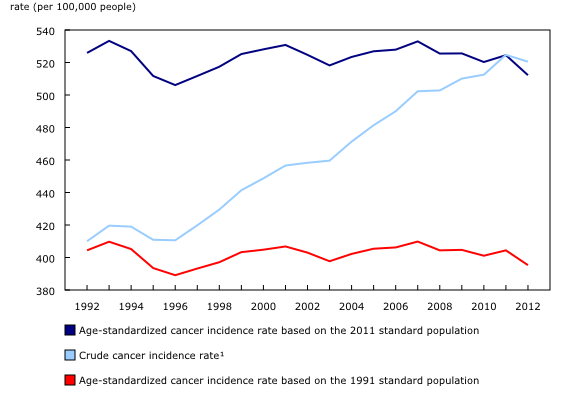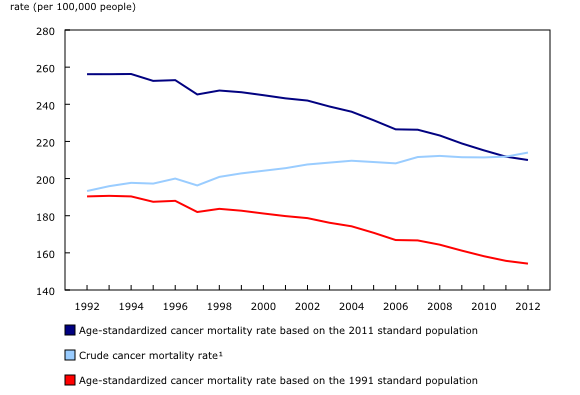Study: Updating the standard population and its effect on cancer incidence and mortality rates, 1992 to 2012
Archived Content
Information identified as archived is provided for reference, research or recordkeeping purposes. It is not subject to the Government of Canada Web Standards and has not been altered or updated since it was archived. Please "contact us" to request a format other than those available.
Released: 2016-10-20
The standard population used to derive age-standardized rates in Canada was recently updated to one based on the 2011 Canadian population. Previously, the standard population was based on the 1991 Canadian population.
As a result of this update, cancer incidence and cancer mortality rates are now calculated using the 2011 standard population. The impact of this change on these rates is the subject of a new study.
For all cancers combined, age-standardized cancer incidence and mortality rates based on the 2011 standard population were consistently higher than those based on the 1991 standard population. For example, the age-standardized cancer incidence rate for 2012 changed from 395.3 to 512.2 per 100,000 people (+29.6%), while the corresponding mortality rate changed from 154.2 to 210.0 per 100,000 people (+36.2%).
However, changes in age-standardized incidence and mortality rates that are attributable to an update of the standard population on which the rates are based do not reflect sudden changes in the risk of developing or dying from cancer. Rather, they reflect the combination of two factors. The first factor is that overall cancer rates increase with age. The second factor is that the updated standard population reflects the aging of the Canadian population from 1991 to 2011. The larger proportion of Canadians in older age groups in the 2011 standard population combined with higher overall cancer incidence and mortality rates at older ages explain the changes in the overall age-standardized cancer rates.
Changes in age-standardized incidence rates resulting from the update of the standard population varied by cancer type. Cancers associated with the largest changes were esophageal cancer (+34.3%), pancreatic cancer (+33.8%), bladder cancer (+33.6%) and multiple myeloma (+33.6%). In contrast, the updated age-standardized rate was 11.5% lower for testicular cancer, while it was virtually unchanged for Hodgkin lymphoma.
Updating the standard population had a negligible effect on trends in overall age-standardized cancer incidence and mortality rates from 1992 to 2012.
Note to readers
The 1991 and 2011 standard populations are respectively based on the final postcensal estimates of the July 1, 1991, Canadian population and those of the July 1, 2011, Canadian population.
The main advantage of the update to the standard population is that age-standardized rates in recent years now more closely reflect actual (crude) rates. While age-standardized rates are hypothetical, they are sometimes mistakenly interpreted as reflecting actual risk. Use of the updated standard will lessen the extent of any such misinterpretation of data for more recent years.
Cancer incidence refers to the number of newly diagnosed cases of cancer. Cancer mortality refers to deaths attributed to cancer.
Age-standardized rates represent the number of new cancer cases or deaths per 100,000 people that would have occurred if the population under study had had the same age distribution as the given standard population. Age-standardization allows for comparisons of incidence or mortality rates over time that are unaffected by changes in the age distribution of the population.
This release presents data from the Canadian Cancer Registry (CCR), a population-based database maintained by Statistics Canada. The CCR contains information on cases diagnosed from 1992 onward, compiled from reports from every provincial and territorial cancer registry.
It also presents data from the Canadian Vital Statistics – Death Database, which collects demographic and cause of death information annually from all provincial and territorial vital statistics registries on all deaths in Canada.
Products
The article "Updating the standard population and its effect on cancer incidence and mortality rates," which is part of the publication Health at a Glance (82-624-X), is now available from the Browse by key resource module of our website, under Publications.
Contact information
For more information, or to enquire about the concepts, methods or data quality of this release, contact us (toll-free 1-800-263-1136; 514-283-8300; STATCAN.infostats-infostats.STATCAN@canada.ca) or Media Relations (613-951-4636; STATCAN.mediahotline-ligneinfomedias.STATCAN@canada.ca).
- Date modified:



